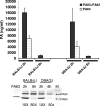Anthrax protective antigen cleavage and clearance from the blood of mice and rats
- PMID: 17724066
- PMCID: PMC2168306
- DOI: 10.1128/IAI.00719-07
Anthrax protective antigen cleavage and clearance from the blood of mice and rats
Abstract
Bacillus anthracis protective antigen (PA) is an 83-kDa (PA83) protein that is cleaved to the 63-kDa protein (PA63) as an essential step in binding and internalizing lethal factor (LF). To assess in vivo receptor saturating PA concentrations, we injected mice with PA variants and measured the PA remaining in the blood at various times using PA83- and PA63-specific enzyme-linked immunosorbent assays. We found that both wild-type PA (WT-PA) and a receptor-binding-defective mutant (Ub-PA) were cleaved to PA63 independent of their ability to bind cells. This suggested a PA-acting protease activity in the blood. The protease cleaved PA at the furin cleavage sequence because furin site-modified PA mutants were not cleaved. Cleavage measured in vitro was leupeptin sensitive and dependent on calcium. Cell surface cleavage was important for toxin clearance, however, as Ub-PA and uncleavable PA mutants were cleared at slower rates than WT-PA. The cell binding-independent cleavage of PA was also verified by using Ub-PA (which is still cleaved) to rescue mice from toxin challenge by competitively binding circulating LF. This mutant was able to rescue mice even when given 12 h before toxin challenge. Its therapeutic ability was comparable to that of dominant-negative PA, which binds cells but does not allow LF translocation, and to the protection afforded through receptor clearance by WT-PA and uncleavable receptor binding-competent mutants. The PA cleavage and clearance observed in mice did not appear to have a role in the differential mouse susceptibility as it occurred similarly in lethal toxin (LT)-resistant DBA/2J and LT-sensitive BALB/cJ mice. Interestingly, PA63 was not found in LT-resistant or -sensitive rats and PA83 clearance was slower in rats than in mice. Finally, to determine the minimum amount of PA required in circulation for LT toxicity in mice, we administered time-separated injections of PA and LF and showed that lethality of LF for mice after PA was no longer measurable in circulation, suggesting active PA sequestration at tissue surfaces.
Figures









Similar articles
-
Cisplatin inhibition of anthrax lethal toxin.Antimicrob Agents Chemother. 2006 Aug;50(8):2658-65. doi: 10.1128/AAC.01412-05. Antimicrob Agents Chemother. 2006. PMID: 16870755 Free PMC article.
-
Activity of the Bacillus anthracis 20 kDa protective antigen component.BMC Infect Dis. 2008 Sep 22;8:124. doi: 10.1186/1471-2334-8-124. BMC Infect Dis. 2008. PMID: 18808698 Free PMC article.
-
Both PA63 and PA83 are endocytosed within an anthrax protective antigen mixed heptamer: a putative mechanism to overcome a furin deficiency.Arch Biochem Biophys. 2006 Feb 1;446(1):52-9. doi: 10.1016/j.abb.2005.11.013. Epub 2005 Dec 7. Arch Biochem Biophys. 2006. PMID: 16384550
-
[Molecular model of anthrax toxin translocation into target-cells].Bioorg Khim. 2014 Jul-Aug;40(4):399-404. doi: 10.1134/s1068162014040098. Bioorg Khim. 2014. PMID: 25898749 Review. Russian.
-
Anthrax toxin.Crit Rev Microbiol. 2001;27(3):167-200. doi: 10.1080/20014091096738. Crit Rev Microbiol. 2001. PMID: 11596878 Review.
Cited by
-
Anthrax edema toxin impairs clearance in mice.Infect Immun. 2012 Feb;80(2):529-38. doi: 10.1128/IAI.05947-11. Epub 2011 Nov 21. Infect Immun. 2012. PMID: 22104108 Free PMC article.
-
Kinetics of lethal factor and poly-D-glutamic acid antigenemia during inhalation anthrax in rhesus macaques.Infect Immun. 2009 Aug;77(8):3432-41. doi: 10.1128/IAI.00346-09. Epub 2009 Jun 8. Infect Immun. 2009. PMID: 19506008 Free PMC article.
-
Bacillus anthracis Virulence Regulator AtxA Binds Specifically to the pagA Promoter Region.J Bacteriol. 2019 Nov 5;201(23):e00569-19. doi: 10.1128/JB.00569-19. Print 2019 Dec 1. J Bacteriol. 2019. PMID: 31570528 Free PMC article.
-
Bacillus anthracis Protective Antigen Shows High Specificity for a UV Induced Mouse Model of Cutaneous Squamous Cell Carcinoma.Front Med (Lausanne). 2019 Feb 12;6:22. doi: 10.3389/fmed.2019.00022. eCollection 2019. Front Med (Lausanne). 2019. PMID: 30809524 Free PMC article.
-
Mechanism of lethal toxin neutralization by a human monoclonal antibody specific for the PA(20) region of Bacillus anthracis protective antigen.Toxins (Basel). 2011 Aug;3(8):979-90. doi: 10.3390/toxins3080979. Epub 2011 Aug 9. Toxins (Basel). 2011. PMID: 22069752 Free PMC article.
References
-
- Bradley, K. A., J. Mogridge, M. Mourez, R. J. Collier, and J. A. Young. 2001. Identification of the cellular receptor for anthrax toxin. Nature 414:225-229. - PubMed
-
- Chekanov, A. V., A. G. Remacle, V. S. Golubkov, V. S. Akatov, S. Sikora, A. Y. Savinov, M. Fugere, R. Day, D. V. Rozanov, and A. Y. Strongin. 2005. Both PA63 and PA83 are endocytosed within an anthrax protective antigen mixed heptamer: A putative mechanism to overcome a furin deficiency. Arch. Biochem. Biophys. 446:52-59. - PubMed
-
- Duesbery, N. S., C. P. Webb, S. H. Leppla, V. M. Gordon, K. R. Klimpel, T. D. Copeland, N. G. Ahn, M. K. Oskarsson, K. Fukasawa, K. D. Paull, and G. F. Vande Woude. 1998. Proteolytic inactivation of MAP-kinase-kinase by anthrax lethal factor. Science 280:734-737. - PubMed
-
- Ezzell, J. W., Jr., and T. G. Abshire. 1992. Serum protease cleavage of Bacillus anthracis protective antigen. J. Gen. Microbiol. 138:543-549. - PubMed
Publication types
MeSH terms
Substances
Grants and funding
LinkOut - more resources
Full Text Sources
Other Literature Sources
Medical

